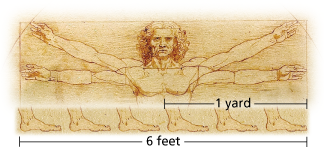-
Although most countries use the metric system, Americans have resisted switching from the customary system to metric. Perhaps one reason is that the customary system evolved naturally in accord with the human body. The metric system is patterned after "base 10" and the circumference of Earth. Here are some examples.
Length
- Inch
- Foot
- Yard
- Mile
Historical Beginning
- The width of a human thumb.
- The length of a human foot.
- The distance from a human nose to the end of an outstretched human arm.
- The distance a human can walk in 1000 paces (two steps).

Pounds, ounces, quarts, gallons, and other measures in the U.S. customary system have similar connections to humans and human activities, such as measuring food, precious metals, and grain.
-
The calendar used in the United States and the one that you are most familiar with is referred to as the Gregorian calendar. This calendar's original purpose was to regulate ceremonial cycles of the Roman Catholic and Protestant churches. Find more information about the origins of this calendar by clicking here.
-
From Example 3, you know that there are
31,536,000 seconds
in a calendar year. Because there are 365.24218967 days in a solar year, there are

in a solar year.
So, there are about 20,925 more seconds in a solar year than in a calendar year.
-
Comments (1)
These comments are not screened before publication. Constructive debate about the information on this page is welcome, but personal attacks are not. Please do not post comments that are commercial in nature or that violate copyright. Comments that we regard as obscene, defamatory, or intended to incite violence will be removed. If you find a comment offensive, you may flag it.
When posting a comment, you agree to our Terms of Use.Showing 1 commentsSubscribe by email Subscribe by RSSRon Larson (author)1 decade ago |You can use the Tool Box at the top of the page to change from one system of units to another. Suppose you bought 80 liters of gasoline in Canada and wanted to know how many gallons you bought. In the Tool Box, choose Volume Converter. Select liter as "From" and gallon as "To". Then, enter 80 in "From" and you will see that 80 liters is about 21.1 gallons. Or, as a rough estimate, you can divide by 4 to see that 80 liters is about 20 gallons.1 0





